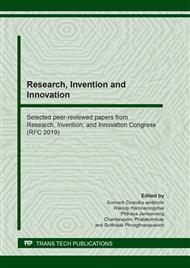p.294
p.303
p.309
p.317
p.323
p.331
p.339
p.347
p.354
Effects of Rubber and Mould Temperatures on the Solid Tire Curing Process
Abstract:
Vulcanization or curing process is a very important process in producing useful rubber products. The quality, performance as well as manufacturing cost of a rubber product are largely affected by the curing process. The curing process takes place when heat is transferred to the rubber compounds inside a heated mould. Curing of a thick article, such as a solid tire, often occurs under transient non-isothermal conditions. The temperature distribution in the rubber significantly affects the cure level distribution throughout the part, especially in a large rubber component. Therefore the ability to predict the distribution of cure level in a rubber part during curing is of great importance for improving the process efficiency and the quality of the final product. In this work, simulations of the curing process of a solid tire, consisting of three layers of different rubber compounds, were performed and the cure level distribution results were evaluated. The simulations are carried out using the commercial finite element software ABAQUS with the cure kinetics model for rubber implemented through the user subroutine UMATHT. The effects of the mold temperature and initial temperature of the solid tire on the cure level distribution and cure time were investigated.
Info:
Periodical:
Pages:
323-330
Citation:
Online since:
August 2020
Price:
Сopyright:
© 2020 Trans Tech Publications Ltd. All Rights Reserved
Share:
Citation:


